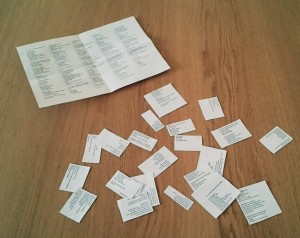We all enjoy scary stories, especially the fantastic ones, when we can be sure nothing that bad will ever happen to us (or so we hope). Halloween seems to be a good time to share some of the English literature masterpieces with our students. From my perspective, most of my students know the most famous films (unfortunately the younger ones rather appreciate Saw than Hitchcock’s Birds), but they have no idea who Edgar Allan Poe or Howard Phillips Lovecraft were (they usually recognise Stephen King, but I’m not writing about King here).
Thinking about Halloween it was the latter author that sprung to my mind – a lot of people have heard the name of Cthulhu, but not even half of them know that it’s a being created by HPL and not a pop-cultural concept. So I thought: why not share some of the stories with my students?
And then I thought: oh, and Neil Gaiman. And A Series of Unfortunate Events. And Ann Rice with her vampires galore. Oh, and that story by Agatha Christie… Looks like something I could share on my blog actually – so here we go:
- Young learners (10+)
It never ceases to amaze me how bloodthirsty children are. Their stories can reek of gore and twisted sense of humour. I guess it’s a way of playing with the taboo, but if we take the real, uncensored Tales by the Grimm brothers, well – I think they might love them.
If you’re not into eye-gauging stuff by the Grimm brothers, you may show your students the eerie world of Neil Gaiman. Coraline would be my book of choice, but I think kids may love The Ocean at the End of the Lane, or The Graveyard Book just as much.
But still, as probably many teachers would agree, it’s A Series of Unfortunate Events that can introduce the world of horror and fantasy to young learners of English, especially with the adorable emphasis on explaining new vocabulary to the reader. I think that the hardships of the Baudelaire siblings don’t grow old.
- Teenagers
Creepypastas seem to be a perfect tool to make your students read, Google, research and explore. You can choose from various sites, for example creepypasta.com and include them in your lesson plans (my absolutely favourite one is Russian Sleep Experiment).
You can also use random short stories as an incentive for their own written compositions.
When it comes to books I’d recommend Ann Rice’s Vampire Chronicles, they are the predecessors of modern stuff known as teenage paranormal romance (Twilight etc.), but it’s way better written, and full of existential suffering we love when we’re 17 😉
I believe teenagers might love Stardust or Good Omens by Neil Gaiman (the latter written with the late sir Terry Pratchett) – maybe not scary per se, but those are definitely worth reading fantasy stories.
- Adults
Have I mentioned Neil Gaiman? I’m sure adult learners will appreciate his Neverwhere or American Gods, or – if they are into weird and scary – The Sandman (which could be a perfect way of presenting a graphic novel as a form of art).
I guess that adult students should have no problems with reading Hallowe’en Party by Agatha Christie. It’s not too scary, I admit, but it’s a really good story and it may give the adults the pleasure of reading an authentic text, solving a crime and experiencing a bit of cultural event, a Halloween party – which may not be celebrated in the students’ native culture.
If you teach adults who are quite proficient in English, I wouldn’t hesitate to share with them the masters of horror and fantasy, Edgar Allan Poe (The Fall of the House of Usher could be easily used as a source text in the classroom) or the ever-underestimated Howard Philips Lovecraft. While HPL’s ideas of the Elder Gods exist somewhere in pop-culture, his stories, sadly, don’t get as much recognition as they deserve. I would share with my students my two favourite stories: The Colour Out of Space and The Dunwich Horror, but be sure to explain historical background, the idea of pulp fiction etc.
I hope the stories I shared will be found useful in your teaching and you’ll enjoy them as much as I do.
Cthulhu ftaghn!







